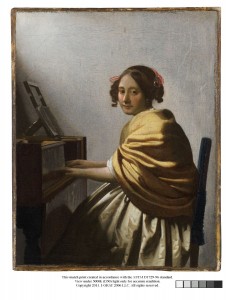
Johannes Vermeer is today widely regarded as one of the great masters of the Dutch Gold Age.
Painted around 1670 Young Woman Seated at a Virginal is one of his last works. Using a simplified style, the Dutch painter depicts a girl playing a virginal, a small keyboard instrument that was popular in Europe in the sixteenth and seventeenth centuries. Her round face and deep-set eyes are typical of the subjects in Vermeer’s work. Vermeer’s women generally lacked conventional beauty and were shown alone, which could be a product of the socioeconomic status of women in seventeenth century Holland. Women in the Dutch Provinces were given more economic and social freedom than was typical in Europe at the time. Dutch women prided themselves on their role as the administrators of the household and keepers of Christian virtue.
This painting is one of Vermeer’s most contested works. Until recently, the painting was rejected as an authentic Vermeer due in large part to the simplified treatment of the yellow shawl draped around the girl’s shoulders. Scholars argue that the shawl was painted too crudely to have been done by the Dutch master himself. Various authentication techniques, such as Raman microscopy, indicated that the shawl might have indeed been added after the painting’s original conception, either by Vermeer or a later owner. However, a study that matched the fibers of the canvas to that of a verified Vermeer piece (The Lacemaker, 1670) has helped to authenticate this painting as a genuine Vermeer.
by Erin Hein